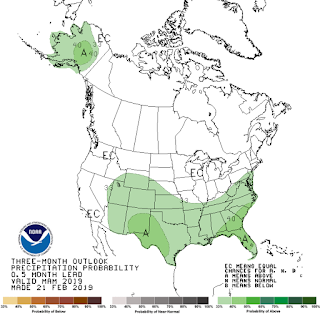By Irene Shonle, Director CSU Extension in Gilpin County
Overall, snowpack in Colorado is great so far this year (statewide, 114% of normal).
 |
| Snotel Current Snow Water Table |
As of February 25th, the South Platte River Basin (our watershed) is 110% of normal and the Arkansas is 125%. West slope river basins range from 107% to 122%. This is great news to urban dwellers, to farmers and ranchers and to states downstream from us to whom we owe water, since that snowpack will soon be melting into water and rushing down the mountains in our streams and rivers. This is especially welcome news after the dismal snowpacks of the last few years.
However, river basin snowpack means very little to us locally. The water many of us mountain dwellers drink comes from wells, and not from reservoirs or large underground aquifers as it does in the flatlands. The production of those wells is entirely dependent on the precipitation that falls in our own yards. It’s very local. And, along the Front Range, from about 7,500’ to 9,000’, we have not gotten great snowfall amounts this year. We are not on the Snotel site, so it doesn’t really show up anywhere, but most of our snowfalls this winter have just been a few inches or so. As one long-time Gilpinite said, you know snowfall has been scarce when 8” seems like a big snow! I have heard reports of wells going dry already this winter. It’s been that way for the last couple of years, and I am hoping for some bigger snows this spring. We need it!
 |
| Aquifer diagram |
Our wells gather water from melting snow and rain seeping into tiny cracks in the bedrock. The ground water held in these cracks is called a fractured rock aquifer and is only recharged by precipitation. Some of these cracks are as narrow as a human hair, and they are all connected to each other for water to be able to travel through them to your well. This ground water recharge system also explains the phenomenon of well water discoloration in the spring – when large quantities of water enter the fractured rock aquifer when the snow melts, sediments, nutrients and tannins can be carried along. Shallower wells tend to see this more frequently -- even after a big rain -- whereas deeper wells see it only in the spring or not at all.
Local moisture also has a big impact on the moisture content of trees and fire danger, and yes, the performance of your perennial plants in your garden. The last few years, at least in Gilpin County, have not seen good summer rains either, so this year it would be good to have some spring snows followed by summer rains. There is a somewhat increased probability for above average precipitation this spring, so here’s to hoping!
 |
| Three-month precipitation outlook |

No comments